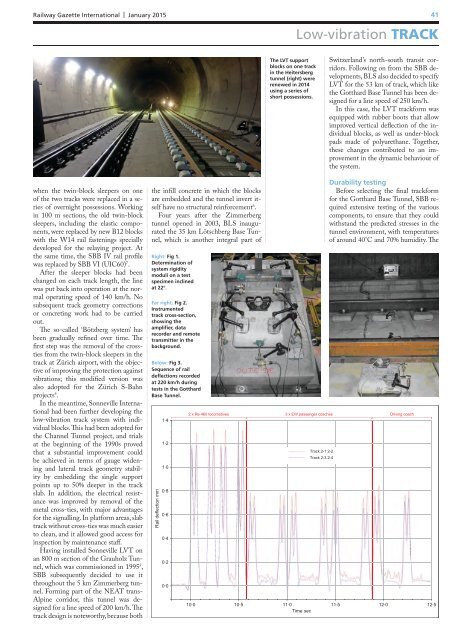Rail conquers the Alps
1spJ1Ka
1spJ1Ka
You also want an ePaper? Increase the reach of your titles
YUMPU automatically turns print PDFs into web optimized ePapers that Google loves.
<strong>Rail</strong>way Gazette International | January 2015 41<br />
Low-vibration TRACK<br />
The LVT support<br />
blocks on one track<br />
in <strong>the</strong> Heitersberg<br />
tunnel (right) were<br />
renewed in 2014<br />
using a series of<br />
short possessions.<br />
Switzerland’s north-south transit corridors.<br />
Following on from <strong>the</strong> SBB developments,<br />
BLS also decided to specify<br />
LVT for <strong>the</strong> 53 km of track, which like<br />
<strong>the</strong> Gotthard Base Tunnel has been designed<br />
for a line speed of 250 km/h.<br />
In this case, <strong>the</strong> LVT trackform was<br />
equipped with rubber boots that allow<br />
improved vertical deflection of <strong>the</strong> individual<br />
blocks, as well as under-block<br />
pads made of polyurethane. Toge<strong>the</strong>r,<br />
<strong>the</strong>se changes contributed to an improvement<br />
in <strong>the</strong> dynamic behaviour of<br />
<strong>the</strong> system.<br />
when <strong>the</strong> twin-block sleepers on one<br />
of <strong>the</strong> two tracks were replaced in a series<br />
of overnight possessions. Working<br />
in 100 m sections, <strong>the</strong> old twin-block<br />
sleepers, including <strong>the</strong> elastic components,<br />
were replaced by new B12 blocks<br />
with <strong>the</strong> W14 rail fastenings specially<br />
developed for <strong>the</strong> relaying project. At<br />
<strong>the</strong> same time, <strong>the</strong> SBB IV rail profile<br />
was replaced by SBB VI (UIC60) 7 .<br />
After <strong>the</strong> sleeper blocks had been<br />
changed on each track length, <strong>the</strong> line<br />
was put back into operation at <strong>the</strong> normal<br />
operating speed of 140 km/h. No<br />
subsequent track geometry corrections<br />
or concreting work had to be carried<br />
out.<br />
The so-called ‘Bötzberg system’ has<br />
been gradually refined over time. The<br />
first step was <strong>the</strong> removal of <strong>the</strong> crossties<br />
from <strong>the</strong> twin-block sleepers in <strong>the</strong><br />
track at Zürich airport, with <strong>the</strong> objective<br />
of improving <strong>the</strong> protection against<br />
vibrations; this modified version was<br />
also adopted for <strong>the</strong> Zürich S-Bahn<br />
projects 4 .<br />
In <strong>the</strong> meantime, Sonneville International<br />
had been fur<strong>the</strong>r developing <strong>the</strong><br />
low-vibration track system with individual<br />
blocks. This had been adopted for<br />
<strong>the</strong> Channel Tunnel project, and trials<br />
at <strong>the</strong> beginning of <strong>the</strong> 1990s proved<br />
that a substantial improvement could<br />
be achieved in terms of gauge widening<br />
and lateral track geometry stability<br />
by embedding <strong>the</strong> single support<br />
points up to 50% deeper in <strong>the</strong> track<br />
slab. In addition, <strong>the</strong> electrical resistance<br />
was improved by removal of <strong>the</strong><br />
metal cross-ties, with major advantages<br />
for <strong>the</strong> signalling. In platform areas, slab<br />
track without cross-ties was much easier<br />
to clean, and it allowed good access for<br />
inspection by maintenance staff.<br />
Having installed Sonneville LVT on<br />
an 800 m section of <strong>the</strong> Grauholz Tunnel,<br />
which was commissioned in 1995 5 ,<br />
SBB subsequently decided to use it<br />
throughout <strong>the</strong> 5 km Zimmerberg tunnel.<br />
Forming part of <strong>the</strong> NEAT trans-<br />
Alpine corridor, this tunnel was designed<br />
for a line speed of 200 km/h. The<br />
track design is noteworthy, because both<br />
<strong>the</strong> infill concrete in which <strong>the</strong> blocks<br />
are embedded and <strong>the</strong> tunnel invert itself<br />
have no structural reinforcement 6 .<br />
Four years after <strong>the</strong> Zimmerberg<br />
tunnel opened in 2003, BLS inaugurated<br />
<strong>the</strong> 35 km Lötschberg Base Tunnel,<br />
which is ano<strong>the</strong>r integral part of<br />
Right: Fig 1.<br />
Determination of<br />
system rigidity<br />
moduli on a test<br />
specimen inclined<br />
at 22°.<br />
Far right: Fig 2.<br />
Instrumented<br />
track cross-section,<br />
showing <strong>the</strong><br />
amplifier, data<br />
recorder and remote<br />
transmitter in <strong>the</strong><br />
background.<br />
Below: Fig 3.<br />
Sequence of rail<br />
deflections recorded<br />
at 220 km/h during<br />
tests in <strong>the</strong> Gotthard<br />
Base Tunnel.<br />
<strong>Rail</strong> deflection mm<br />
1∙4<br />
1∙2<br />
1∙0<br />
0∙8<br />
0∙6<br />
0∙4<br />
0∙2<br />
0∙0<br />
Track 2-1 2-2<br />
Track 2-3 2-4<br />
Durability testing<br />
Before selecting <strong>the</strong> final trackform<br />
for <strong>the</strong> Gotthard Base Tunnel, SBB required<br />
extensive testing of <strong>the</strong> various<br />
components, to ensure that <strong>the</strong>y could<br />
withstand <strong>the</strong> predicted stresses in <strong>the</strong><br />
tunnel environment, with temperatures<br />
of around 40°C and 70% humidity. The<br />
2 x Re 460 locomotives 3 x EW passenger coaches Driving coach<br />
10∙0 10∙5 11∙0 11∙5 12∙0 12∙5<br />
Time sec


